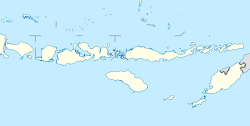Alor Regency
Kabupaten Alor | |
|---|---|
 Road in Maritaing, Eastern Alor Island | |
 Location within East Nusa Tenggara | |
Location in Lesser Sunda Islands and Indonesia | |
| Coordinates: 8°18′S 124°30′E / 8.3°S 124.5°E | |
| Country | |
| Province | |
| Capital | Kalabahi |
| Government | |
| • Regent | Amon Djobo |
| • Vice Regent | Imran Duru |
| Area | |
| • Total | 1,130.85 sq mi (2,928.88 km2) |
| Population (mid 2023 estimate)[1] | |
| • Total | 221,536 |
| • Density | 200/sq mi (76/km2) |
| Time zone | UTC+8 (ICST) |
| Area code | (+62) 386 |
| Website | alorkab |
Alor Regency (Indonesian: Kabupaten Alor) is a regency (kabupaten) in East Nusa Tenggara (NTT) province of Indonesia. Established in 1958,[2] Alor Regency administers the Alor Archipelago with its seat (capital) in Kalabahi on Alor Island.
Alor Regency occupies 2,928.88 km2 land area and 10,973.62 km2 water area. There are seventeen islands in the archipelago, of which the largest by far are Alor itself and Pantar; there are another six inhabited islands (including Pura, Treweng, Kepa, Buaya, Kangge and Kura); the remaining nine islands (Sika, Nub, Kapas, Batang, Lapang, Ternate, Rusa, Tikus and Kambing) are uninhabited. To the east lies the island of (Atauro), part of the Republic of East Timor. Pantar and Alor Islands are separated by a wide strait with Pulau Buaya and Pulau Kambing at its northern point, Pulau Pura in the middle, and Pulau Treweng at its southern point. The regency had 190,026 inhabitants at the 2010 decennial census;[3] at the 2020 census this had risen to 211,872;[4] the official estimate as at mid 2023 was 221,536 - comprising 109,620 males and 111,916 females.[1]
The main transportation access in the regency is by means of sea. The state-owned PELNI sea liners operate in the archipelago for major transport to the main port hub in Kalabahi beside small boats operating between small islands. A small Perintis Mali airstrip (18 km east of Kalabahi) can only be used by small CASA airplanes, operated by Merpati Nusantara Airlines.
As is the case in other parts of NTT province, the provision of education is often a major problem, especially in remote areas. In recent years, the district (regency) government has been trying to make it easier for children to attend school by, amongst other things, increasing the number of one-roof junior high schools. The standard of teaching is often also a major problem because many teachers lack proper qualifications.[5]
- ^ a b Badan Pusat Statistik, Jakarta, 28 February 2024, Kabupaten Alor Dalam Angka 2024 (Katalog-BPS 1102001.5305)
- ^ Government of Indonesia (9 August 1958), Establishment of the Second-level Administrative Regions under the First-level Administrative Region of Bali, West Nusa Tenggara and East Nusa Tenggara (in Indonesian ed.), Indonesia Ministry of Law and Justice, UU No. 69/1958, retrieved 2007-08-24[permanent dead link]
- ^ Biro Pusat Statistik, Jakarta, 2011.
- ^ Badan Pusat Statistik, Jakarta, 2021.
- ^ Yennis Fointuna, 'Schooling: Alor govt strives to improve education', The Jakarta Post, 16 June 2012.


